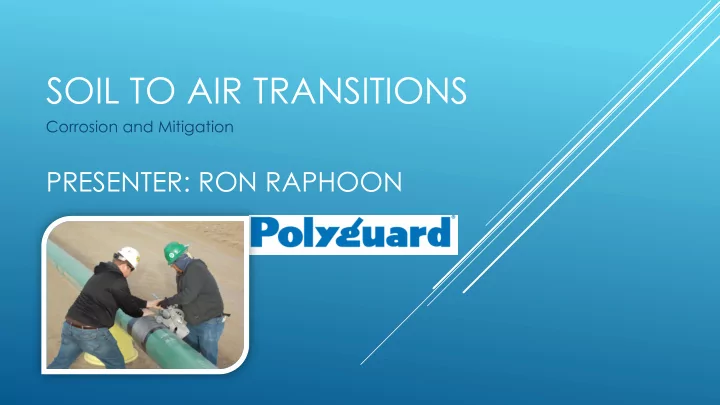

SOIL TO AIR TRANSITIONS Corrosion and Mitigation PRESENTER: RON RAPHOON
WHAT WE ARE TALKING ABOUT Soil to Air Transition: The Soil to Air Interface is the area above and below the natural ground level where corrosion is most likely to occur. It is an area greatly affected by moisture levels, certain bacteria, temperatures, oxygen levels and pH levels. An increase in corrosion can also occur if this area is exposed to agricultural fertilizers, animal excrement and any chemicals with excessive pH levels.
PROTECT OR REPLACE! TITLE 49 §193.2625 CORROSION PROTECTION. (a) Each operator shall determine which metallic components could, unless corrosion is controlled, have their integrity or reliability adversely affected by external, internal, or atmospheric corrosion during their intended service life. (b) Components whose integrity or reliability could be adversely affected by corrosion must be either — (1) Protected from corrosion in accordance with §§193.2627 through 193.2635, as applicable; or (2) Inspected and replaced under a program of scheduled maintenance in accordance with procedures established under §193.2605.
COATING IS REQUIRED! TITLE 49 §195.581 Subpart H — Corrosion Control Which pipelines must I protect against atmospheric corrosion (a) You MUST coat each pipeline or portion of pipeline that is exposed to the atmosphere Except section (c) WITH (b) Coating material suitable for the prevention of atmospheric corrosion. (c) Except portions of pipelines in offshore splash zones or soil-to-air interfaces, you need not protect against atmospheric corrosion any pipeline for which you demonstrate by test, investigation, or experience appropriate to the environment of the pipeline that corrosion will — (1) Only be a light surface oxide; or (2) Not affect the safe operation of the pipeline before the next scheduled inspection.
CP TOO! TITLE 49 §193.2629 EXTERNAL CORROSION CONTROL (a) Each buried or submerged component that is subject to external corrosive attack must be protected from external corrosion by — (1) Material that doesn’t corrode OR (i) An external protective coating designed to meet §192.461 AND (ii) A cathodic protection system designed to protect components in their entirety
THIS ISN’T A NEW PRACTICE TITLE 49 §192.455 EXTERNAL CORROSION CONTROL Buried or submerged pipelines installed after July 31, 1971 (a) must be protected against external corrosion, including the following: (1) It must have an external protective coating meeting the requirements of §192.461 (2) It must have a cathodic protection system designed to protect the pipeline in accordance with this subpart, installed and placed in operation within 1 year after completion of construction.
TITLE 49: §192.461 EXTERNAL CORROSION PROTECTIVE COATING (a) Each external protective coating, whether conductive or insulating, applied for the purpose of external corrosion control must — (1) Be applied on a properly prepared surface; (2) Have sufficient adhesion to the metal surface to effectively resist underfilm migration of moisture; (3) Be sufficiently ductile to resist cracking; (4) Have sufficient strength to resist damage due to handling and soil stress; and (5) Have properties compatible with any supplemental cathodic protection.
FRESHLY COATED TO PREVENT CORROSION
WHAT CORROSION?
LOSS OF WALL THICKNESS
CRACKING
DISBONDMENT
COATING SOLUTIONS A. Epoxy A. FBE B. 2-Part B. Heat Shrink Sleeves C. Wax Tape D. Composite Repair Systems E. UV Stable Tapes F. Fiberglass/ Tape Combination
EPOXY – FBE OR 2-PART Abrasion + In Service FBE – 2part + Adhesion + Tapered Finish + CP Friendly + UV Stable – Flexibility –
HEAT SHRINK SLEEVES Abrasion + In Service – Adhesion + Tapered Finish + CP Friendly + UV Stable – Flexibility –
WAX TAPE Abrasion - In Service + Adhesion - Tapered Finish + CP Friendly ? UV Stable + Flexibility +
COMPOSITE REPAIR SYSTEMS Abrasion + In Service + Adhesion + Tapered Finish – CP Friendly – UV Stable +/ – Flexibility –
SOLID FILM BACKED TAPES Abrasion – In Service + Adhesion +/ – Tapered Finish + CP Friendly – UV Stable + Flexibility +
FIBERGLASS POLYURETHANE WRAP Abrasion + In Service + Adhesion + Tapered Finish + CP Friendly + UV Stable + Flexibility +/ –
ITS COATED, NOW WHAT? What does the code require? Conduct Inspections every 3 years and monitor Recommend yearly checks during annual leak surveys What does the IURC expect? For those that use consultants, review their submitted documentation for any remedial action items. Remedial action is to take place within one year from the time of discovery What are we seeing? The soil ‐ to ‐ air interface needs more attention. Disbonded coating can hold water next to the pipe and cause severe rusting and delaminating of the steel.
RD-6 Field Joint Coating
Recommend
More recommend